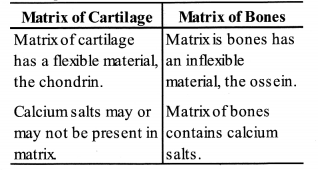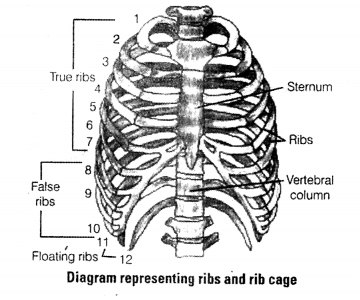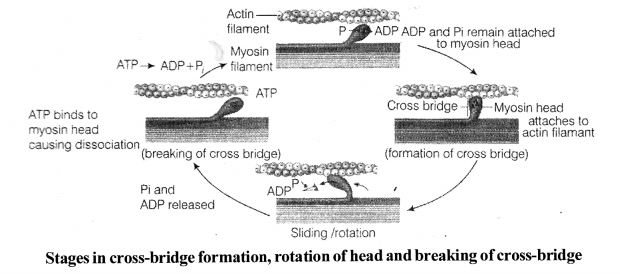NCERT Exemplar Solutions for Class 11 Biology Chapter 20 Locomotion and Movement
These Solutions are part of NCERT Exemplar Solutions for Class 11 Biology. Here we have given NCERT Exemplar Solutions for Class 11 Biology Chapter 20 Locomotion and Movement.
VERY SHORT ANSWER QUESTIONS
Question 1.
Name the cells/ tissues in human body which
(a) exhibit amoeboid movement
(b) exhibit ciliary movement
Solution:
(a) Macrophages and leucocytes in blood exhibit amoeboid movement. Cytoskeletal elements like microfilaments are also involved in amoeboid movement.
(b) Ciliary Movement occurs mostly in the internal organs, lined by the ciliated epithelium, e.g., cilia in trachea helps in removing dust particle and foreign substances inhaled along with atmospheric air.
Passage of ova through the female reproductive tract is also facilitated by the ciliary movement. This is due to the presence of ciliated epithelium in the Fallopian tube.
Question 2.
Locomotion requires a perfect coordinated activity of muscular …… systems.
Solution:
Locomotion requires a prefect coordinated activity of muscular, skeletal and neural systems.
Question 3.
Sarcolemma, sarcoplasm and sarcoplasmic reticulum refer to particular type of cell in our body. Which is this cell and to what parts of that cell do these names refer to?
Solution:
Muscle fibre is lined by the plasma membrane called sarcolemma. Muscle fibre is a syncitium because sarcoplasm (the cytoplasm) of muscle fibre contains number of nuclei and sarcoplasmic reticulum is the endoplasmic reticulum of the muscle fibre and is the store house of calcium ions.
Question 4.
Label the different components of actin filament in the diagram given below

Solution:
Each actin filament is made of two ‘F (filamentous) actins helically wound to each other and each ‘F’ actin is a polymer of monomeric ‘G’ (globular) actins.
The different components of action filament can be represented as

Question 5.
What is the difference between the matrix of bones and cartilage?
Solution:
Difference between the matrix of ones and cartilage

Question 6.
Which tissue is affected by mysthenia gravis? What is the underlying cause.
Solution:
Myasthenia gravis is autoimmune disorder of skeletal muscle, which affects neuromuscular junction, that leads to fatigue, weakening and paralysis of the skeletal muscle.
Question 7.
How do our bone joints function without grinding noise and pain?
Solution:
The presence of synovial fluid, between articulating surface of the two bones enclosed within synovial cavity of synovial joints to enables out joints to function without grinding noise and pain.
Question 8.
Give the location of a ball and socket joint in a human body.
Solution:
In human body Ball and socket joint are present between humerus and pectoral girdle. These joints allows free movement of bone in all direction. E.g., shoulder joints (humerus bone in socket of pectoral girdle) and
SHORT ANSWER QUESTIONS
Question 1.
With respect to rib cage, explain the following
(a) bicephalic ribs
(b) true ribs
(c) floating ribs
Solution:
There are 12 pairs of ribs. Each rib consist of a thin flat bone dorsally connected to the vertebral column and ventrally to the sternum.
(a) Bicephalic ribs each rib has two articulating surfaces on its dorsal end hence, are called as bicephatic ribs.
(b) The first seven pairs of ribs are true ribs. These ribs are dorsally attached to the thoracic vertebrae and ventrally connected to the sternum with the help of hyaline cartilage.
(c) The last two pair (11th and 12th) of ribs are not connected ventrally to the sternum therefore, called as floating ribs.

Question 2.
Exchange of calcium between bone and ^extracellular fluid takes place under the
influence of certain hormones
(a) What will happen if of Ca2+ is in extracellular fluid?
(b) What will happen if very less amount of Ca2+ is in the extracellular fluid?
Solution:
Parathyroid and thyroid glands, function under the feed back control of blood calcium
(a) More Ca2+ concentration in extracellular fluid is associated with hyperparathyroidism. It causes demineralisation, resulting in softening and bending of the bones. This condition leads to osteoprosis.
(b) Very less amount of Ca2+ in extracellular fluid is associated with hypoparathyroidism. This increases the excitability or nerves and muscles, causing cramps, sustained contraction of the muscles of larynx, face, hands and feet. This disorder called parathyroid tetany or hypercalcemic tetany.
Question 3.
Rahul exercises regularly by visiting a gymnasium. Of late he is gaining weight. What could be the reasons? Choose the correct answer and elaborate.
(a) Rahul has gained weight due to accumulation of fats in body
(b) Rahul has gained weight due to increased muscle and less of fat
(c) Rahul has gained weight because his muscle shape has improved
(d) Rahul has gained weight because he is accumulating water in the body
Solution:
(b) Rahul has gained weight because the shape of his muscle has changed. Regular exercise increases the body muscle. There is an enlargement of muscles due to increase in the amount of sarcoplasm and mitochondria and the strength he to developed led him to gain the mass and size of body muscle and reduction in fat content.
Question 4.
Radha was running on a treadmill at a great speed for 15 minutes continuously. She stopped the treadmill and abruptly came out. For the next few minutes, she was breathing heavily/fast. Answer the following questions.
(a) What happened to her muscles when she did strenuously exercised?
(b) How did her breathing rate change?
Solution:
(a) Her muscles got fatigues due to continuous exercise because of the accumulation of lactic acid within skeletal muscles. Pain is also often experienced in the fatigued muscles.
(b) Her breathing rate changes from normal to
high as during as her body muscles require thus oxygen for the ATP production, than the normal value, her breathing thus enhances, to take most oxygen from the atmosphere.
Question 5.
Write a few lines about gout.
Solution:
Gout is a disease caused due to improper purine metabolism. It causes accumulation of uric acid and its crystals in the joints. The level of uric acid and crystals of its salts get raised in blood causing their accumulation in the joint to which causes gouty arthritis. The excess of urates in blood can also lead to the formation stones in the kidneys.
Question 6.
What are the points for articulation of pelvic and pectoral girdles?
Solution:
- Each half of the pectoral girdle consist of a clavicle and a scapula.
- The dorsal flat, triangular body of scapula has a slightly elevated ridge called the spine that, projects flat expanded process called the acromion and the clavicle articulating with it.
- There a depression below the acromion is called the glenoid cavity which articulates with the head of the humerous to form the shoulder joint.
- Pelvic girdle consist of two coxal bones, each formed by the fusioin of three bones, ilium, ischium and pubis. It articulates with femur through a cavity called acetabulum forming thigh joint.
LONG ANSWER QUESTIONS
Question 1.
How does a muscle shorten during its contracting and return to its original form during relaxation?
Solution:
Muscles contract due to formation of cross-bridge between the actin and myosin filament
(i) An ATP molecule j oins the active site on the head of myosin myofilament. These heads contains an enzyme, myosin ATPase along with Ca2+ and Mg2+ ions that catalyses the break down of ATP.
![]()
(ii) The energy is transferred to myosin head which straightens to join an active site on actin myofilament, forming a across-

(iii) The energised cross-bridges move, causing the attached actin filaments to move towards the centre of A-band. The Z-line is also pulled inwards causing shortening of sarcomere, contraction. During contraction A-bands retain the length, while I-bands get reduced.
(iv) The myosin head releases ADP and Pi where relaxes to its low energy state. The head detaches from actin myofilaments when new ATP molecule joins it and cross-bridge are broken.
(v) In the next cycle, the free head cleaves the new ATP. The cycles of cross-bridge formation and breakage is repeated causing further sliding.

(vi) After contraction muscle relaxation occurs when the calcium ions are pumped back to the sarcoplasmic cistemae, thus, blocking the sites on actin myofilaments. The Z-line returns to original positions or relaxation.
We hope the NCERT Exemplar Solutions for Class 11 Biology at Work Chapter 20 Locomotion and Movement, help you. If you have any query regarding NCERT Exemplar Solutions for Class 11 Biology at Work Chapter 20 Locomotion and Movement, drop a comment below and we will get back to you at the earliest.